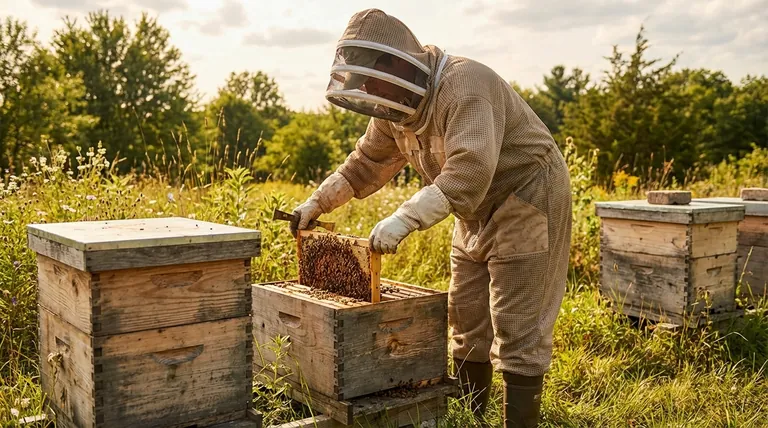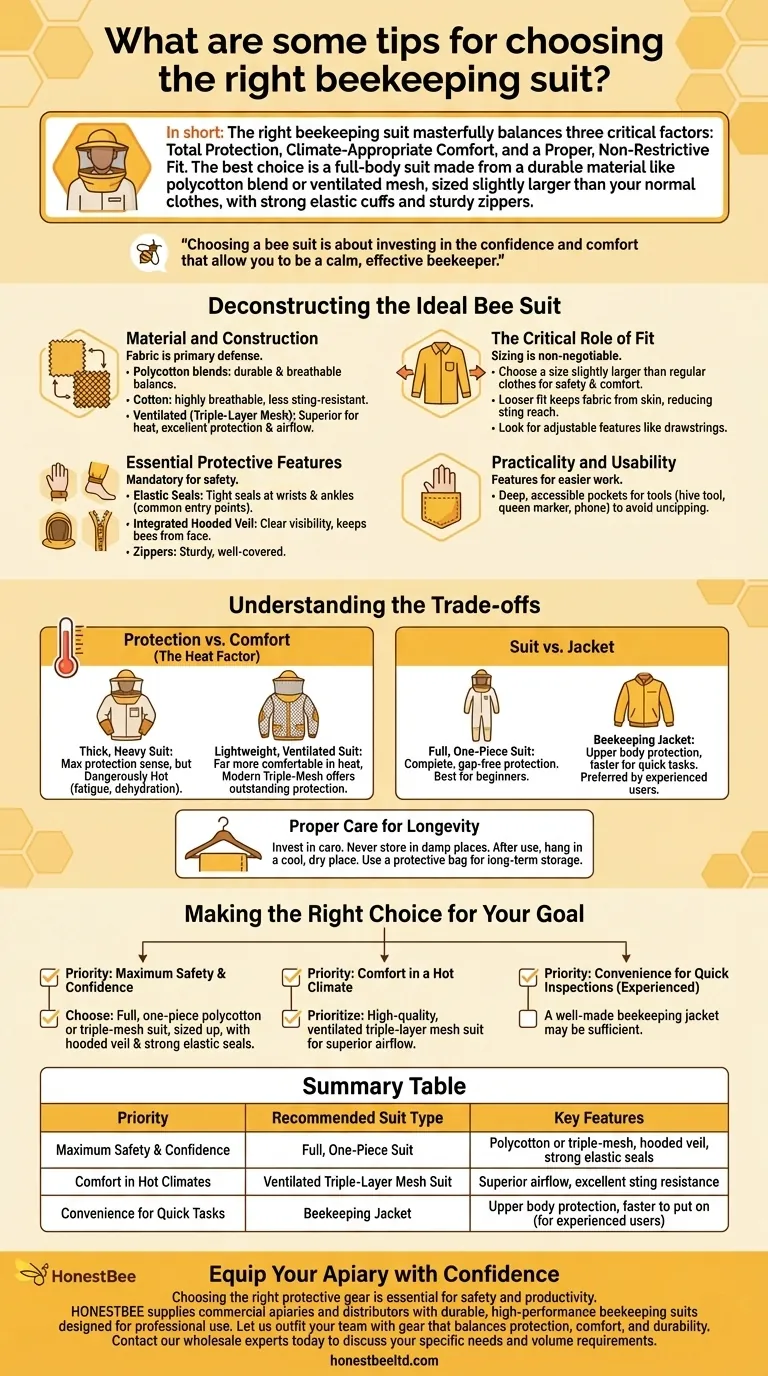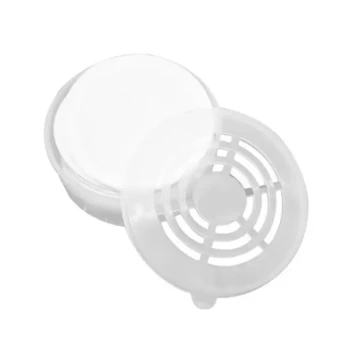In short, the right beekeeping suit masterfully balances three critical factors: total protection, climate-appropriate comfort, and a proper, non-restrictive fit. The best choice is a full-body suit made from a durable material like a polycotton blend or ventilated mesh, sized slightly larger than your normal clothes to ensure a loose fit, and sealed with strong elastic cuffs and sturdy zippers.
Choosing a bee suit is not merely about preventing stings; it's about investing in the confidence and comfort that allow you to be a calm, effective beekeeper. The ideal suit is a functional tool that adapts to your specific climate and work style.

Deconstructing the Ideal Bee Suit
A modern bee suit is more than just a piece of clothing; it's a system of protection. Understanding its individual components helps you evaluate quality and make an informed decision.
Material and Construction
The fabric of your suit is your primary line of defense. Polycotton blends are a common choice, offering a good balance of durability and breathability. Pure cotton is highly breathable but may be less sting-resistant than thicker materials.
For beekeepers in warmer regions, ventilated suits are the superior option. These often feature a triple-layer mesh construction that provides excellent protection while allowing for maximum airflow, significantly reducing the risk of overheating.
The Critical Role of Fit
Proper sizing is non-negotiable for both safety and comfort. Always choose a suit that is slightly larger than your regular clothing size, as it will be worn over your clothes.
A looser fit serves a crucial purpose: it keeps the fabric away from your skin. This extra space means a bee's stinger is less likely to reach you even if it penetrates the material. Look for suits with adjustable features like drawstrings or elastic waistbands to customize the fit.
Essential Protective Features
Certain features are mandatory for a suit to be considered safe. Ensure your suit has tight, elastic seals at the wrists and ankles. These are the most common entry points for bees, and a weak seal is a major vulnerability.
The suit must include an integrated hooded veil that offers clear visibility while keeping bees away from your face. Finally, inspect the zippers; they should be sturdy and well-covered to prevent bees from getting through.
Practicality and Usability
Beyond basic protection, consider features that make your work easier. Deep, accessible pockets are invaluable for holding hive tools, queen markers, or your phone. The goal is to have everything you need without having to unzip any part of your suit during an inspection.
Understanding the Trade-offs
No single suit is perfect for every person in every situation. You must weigh the competing priorities to find your optimal balance.
Protection vs. Comfort (The Heat Factor)
This is the central dilemma for most beekeepers. A thick, heavy suit offers a psychological and physical sense of maximum protection but can become dangerously hot, leading to fatigue and dehydration.
A lightweight, ventilated suit is far more comfortable in the heat but may feel less substantial to a nervous beginner. However, modern triple-mesh designs provide outstanding protection and are the recommended choice for most climates.
Suit vs. Jacket
A full, one-piece suit offers complete, gap-free protection. This is the best choice for beginners, as it eliminates worries about bees finding a gap at your waist, allowing you to focus on learning.
A beekeeping jacket offers protection for the upper body and is faster to put on for quick tasks. It's often preferred by experienced beekeepers who are comfortable with the increased risk of a bee crawling up under the hem.
Proper Care for Longevity
A quality bee suit is an investment that requires proper care. Never store your suit in a damp basement or garage, as moisture will degrade the fabric and promote mildew.
After use, hang your suit in a cool, dry place. For long-term storage, placing it in a protective bag will keep it clean and free from dust and pests.
Making the Right Choice for Your Goal
Your ideal suit depends entirely on your priorities. Use these guidelines to make a final decision.
- If your primary focus is maximum safety and confidence: Choose a full, one-piece polycotton or triple-mesh suit, sized up, with a hooded veil and strong elastic seals.
- If your primary focus is comfort in a hot climate: Prioritize a high-quality, ventilated triple-layer mesh suit for its superior airflow.
- If your primary focus is convenience for quick inspections (and you have experience): A well-made beekeeping jacket may be sufficient for your needs.
Ultimately, the right protective gear empowers you to work with your bees calmly and effectively, turning a potentially stressful task into a rewarding one.
Summary Table:
| Priority | Recommended Suit Type | Key Features |
|---|---|---|
| Maximum Safety & Confidence | Full, One-Piece Suit | Polycotton or triple-mesh, hooded veil, strong elastic seals |
| Comfort in Hot Climates | Ventilated Triple-Layer Mesh Suit | Superior airflow, excellent sting resistance |
| Convenience for Quick Tasks | Beekeeping Jacket | Upper body protection, faster to put on (for experienced users) |
Equip Your Apiary with Confidence
Choosing the right protective gear is essential for the safety and productivity of your beekeeping operation. At HONESTBEE, we supply commercial apiaries and equipment distributors with durable, high-performance beekeeping suits and supplies designed for professional use.
Let us help you outfit your team with gear that balances protection, comfort, and durability. Contact our wholesale experts today to discuss your specific needs and volume requirements.
Visual Guide

Related Products
- Wholesales Dadant Size Wooden Bee Hives for Beekeeping
- Yellow Plastic Bucket Pail Perch for Beekeeping
- Professional Insulated Plastic Bee Hives
- Long Langstroth Style Horizontal Top Bar Hive for Wholesale
- Professional Insulated Winter Hive Wrap for Beekeeping
People Also Ask
- What is the best place to keep bees? Find the Perfect Apiary Site for Your Hives
- What are the characteristics of oil-based paint for beehives? Durability vs. Modern Practicality
- What is beekeeping equipment? Essential Tools for Commercial Apiaries & Distributors
- What should you do if you find an ant nest near your beehive? Essential Strategies for Hive Protection
- What types of products are available for beekeeping needs? Essential Equipment for Apiaries & Distributors



















